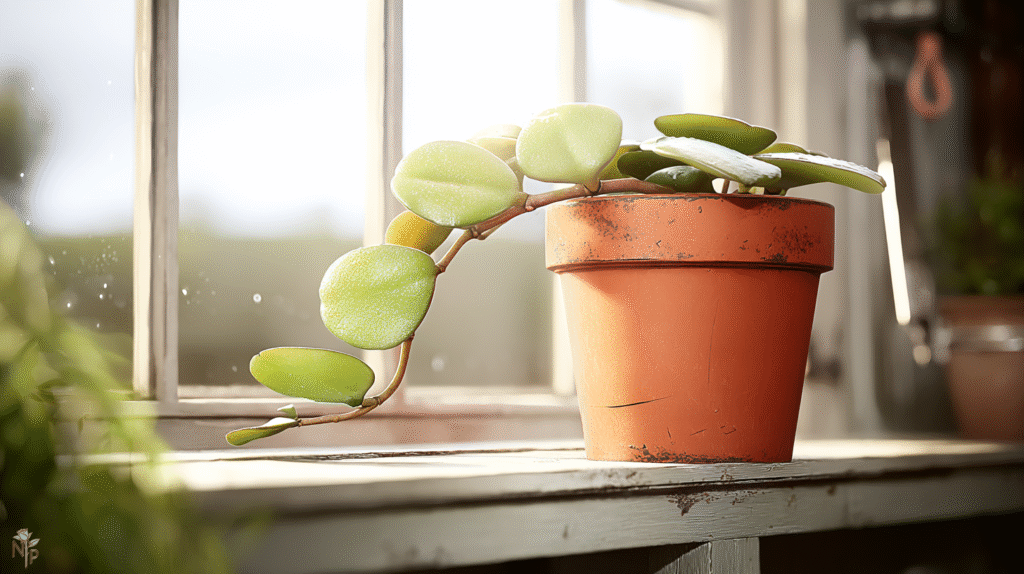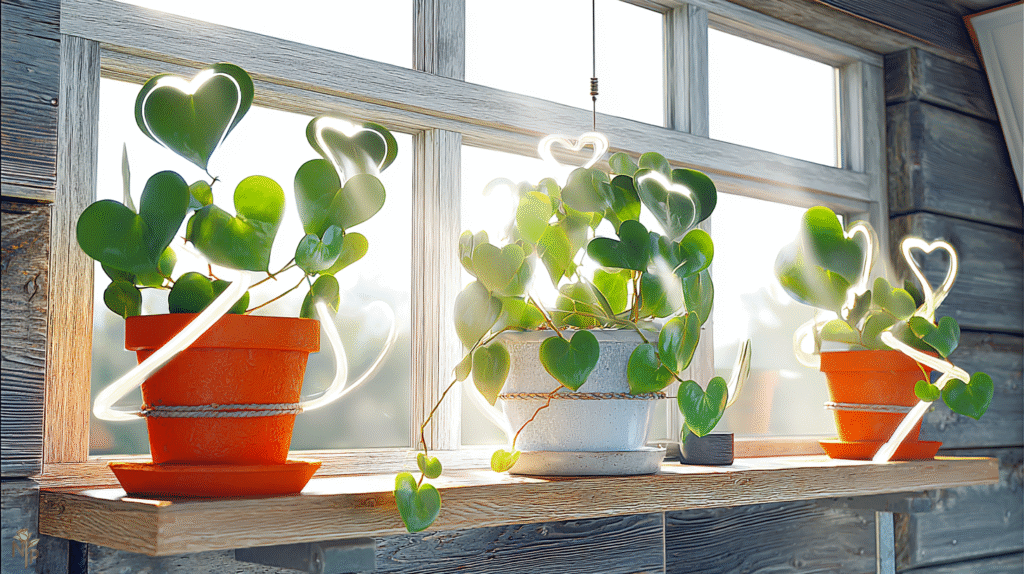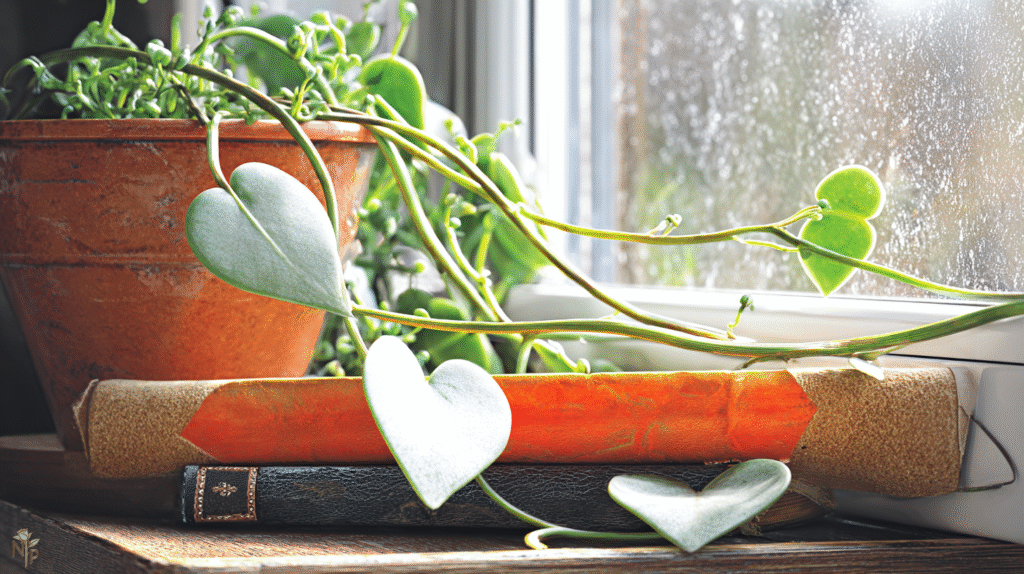That little heart-shaped leaf in a pot they sell everywhere for Valentine’s Day? Yeah, I bought three of them over two years thinking I kept killing them. Turns out they weren’t dying – they just weren’t really plants.
Here’s what nobody tells you: those single leaf cuttings will stay a single leaf forever unless they have a piece of stem node attached. I had a zombie leaf sitting in a pot for 18 months, alive but never growing, before I learned this $8 lesson. Meanwhile, my actual Kerrii Hoya with stems is now six feet long and producing new hearts monthly.
After wasting probably $40 on doomed single leaves and nearly killing my first real Kerrii twice, I finally figured these weird little hearts out. They’re actually one of the easiest hoyas once you understand they’re succulents pretending to be houseplants, not houseplants pretending to be succulents.

Understanding the Single Leaf Scam
Why Single Leaves Don’t Grow
Those Valentine’s Day heart leaves are basically plant taxidermy. Without a stem node (that little bump where leaves attach to stems), they can’t produce new growth. They’ll photosynthesize and stay green for literally years, but never grow a single new leaf.
I kept one alive for two years thinking I was doing something wrong. Posted it online asking for help. Someone finally told me the truth – it’s like expecting a fingernail clipping to grow into a hand.
How to Spot a Real Kerrii Plant
Look for multiple leaves on a vine, not just one heart in dirt. Real Kerrii has thick, succulent stems that vine and climb. The leaves grow in pairs along the stem. If you’re buying online, ask specifically if it includes stem nodes. Learned this after my fourth single-leaf purchase.
The Price Difference Reality
Single leaf: $5-10 (stays a single leaf forever) Actual plant with stems: $25-50 (grows into massive vine) The real plant costs more but actually, you know, grows. Revolutionary concept.
Light Requirements That Actually Work
The Bright Light Truth
Every care guide says “bright indirect light” but my Kerrii in bright indirect light grew exactly one leaf in eight months. Moved it to a south window getting 4 hours of direct sun daily – six new leaves in two months.
These aren’t delicate flowers. They’re succulents from Thailand that grow on trees in full tropical sun. My healthiest Kerrii gets morning sun from 7 AM to noon. The leaves are thick, deep green, and rock hard.
Signs of Insufficient Light
- Pale, yellowish leaves (not yellow from overwatering – different yellow)
- Gaps between leaves get longer (reaching for light)
- No new growth for months
- Thin, floppy new leaves instead of thick succulent ones
My bathroom Kerrii with just a frosted window? Still alive after a year but has grown exactly zero new leaves. The one blasted by sun? Growing like it’s training for a marathon.
Grow Light Alternative
Didn’t have another sunny window so I put one under a $25 LED grow light from Amazon. Twelve hours daily, positioned 8 inches away. Not as good as real sun but way better than a dark corner. Grows about half the speed of my sun-blasted one.
Watering: The Less-Is-More Approach
The Succulent Secret
Kerrii Hoya is a succulent. Those thick, waxy leaves store water. Water it like a succulent, not a tropical houseplant. I killed my first one treating it like my pothos – weekly watering turned it to mush in a month.
Now I water every 3-4 weeks in summer, every 6 weeks in winter. The leaves literally feel different when thirsty – slightly softer, less rigid. When properly hydrated, they’re hard as plastic.
The Soak and Dry Method
Water thoroughly until it runs out drainage holes, then leave it alone for weeks. No little sips, no misting, no constant moisture. Think desert rainstorm, not daily drizzle.
I literally mark my calendar because I’ll forget otherwise. “Water heart plant” every fourth Sunday. Sounds excessive but after killing one with root rot, I’m not taking chances.
Water Quality Matters
Tap water works fine unless yours is super hard. Mine has 400 ppm dissolved solids and the Kerrii doesn’t care. But if you see white crusty buildup on soil or leaves, switch to filtered. Not as picky as Calatheas but not immune to mineral buildup.
Soil and Potting Secrets
The Perfect Mix
Regular potting soil will kill your Kerrii. Holds too much water, doesn’t drain fast enough. After root rot disaster number one, I developed this mix:
- 40% cactus soil
- 30% perlite
- 20% orchid bark
- 10% coarse sand
Drains in seconds, dries in days. When I water, it flows through immediately. No standing water, no soggy soil, no root rot.
Container Choice
Terracotta pots only. Plastic holds too much moisture. My Kerrii in plastic got root rot despite perfect soil and careful watering. Moved survivors to terracotta – problem solved.
Size matters too. These like being slightly root-bound. My huge Kerrii is in a 6-inch pot and happy. Too big a pot = soil stays wet too long = dead plant.
When to Repot
Every 2-3 years max. Mine hadn’t been repotted in three years when I got it (Facebook marketplace score). Still thriving. Only repot when roots literally burst through drainage holes or growth completely stops.

Growth Patterns and Expectations
The Waiting Game
Kerrii grows in spurts, not steadily. Mine does nothing for three months, then shoots out a 12-inch vine with four leaves in two weeks, then goes dormant again. First time this happened I thought it died mid-growth. Nope, just taking a break.
Supporting the Vines
These are climbing plants. In nature, they climb trees. In your house, they need support or become a tangled mess. I use:
- Bamboo poles for young plants
- Moss pole for my big one (they attach aerial roots to it)
- Command hooks on walls for creative shapes
My friend has hers growing in a heart shape around a wire frame. Took two years to train but looks incredible.
Flowering Reality
Everyone asks about the flowers. Yes, they flower, but only mature plants (usually 3+ years old) with perfect conditions. Mine is four years old, six feet long, and has never flowered. I’ve accepted this. The leaves are cute enough.
Common Problems I’ve Encountered
Root Rot Recovery
Overwatered my first one. Leaves went yellow, then soft, then fell off. Unpotted it – roots were black mush. Cut off all rotten roots (90% of them), let it dry for two days, repotted in dry cactus soil. It survived and is now my biggest plant. These things are tough if you act fast.
Mealybug Invasion
White fuzzy bugs love hiding where leaves meet stems. Discovered them after wondering why new growth was deformed. Cotton swab with rubbing alcohol, check weekly, problem solved. Now I preventatively check monthly.
The Variegated Disappointment
Bought a “variegated” Kerrii for $60. The variegation disappeared within six months as new growth came in solid green. Turns out they need massive light to maintain variegation. Unless you have a greenhouse, expect variegated ones to revert.

My Current Setup
The Windowsill Winner
South-facing window, terracotta pot, cactus soil mix. Water monthly-ish when leaves feel soft. Zero fertilizer (forgot for a year, didn’t matter). Grows 2-3 feet annually.
The Propagation Station
Every cutting roots easily in water. I’ve given away probably 20 plants. Just cut below a node, stick in water, wait 3 weeks for roots, pot up. Success rate is literally 100% if the cutting has a node.
The Single Leaf Museum
Still have my original single leaf purchase from three years ago. It’s alive, green, and exactly the same size. I keep it as a reminder of my $8 stupidity and to show people what not to buy.
The Bottom Line
Kerrii Hoya is stupid easy if you:
- Buy an actual plant with stems, not a single leaf
- Give it way more light than you think
- Water it way less than you think
- Use cactus soil in terracotta
- Accept that it grows when it feels like it
Mine went from a three-leaf cutting to a six-foot vine that everyone comments on. Just remember: these are succulents that happen to be cute, not cute plants that happen to be succulent. Treat them like cactus that grows heart-shaped leaves and you’ll have more vines than you know what to do with.






